An ecological crisis may not be what comes to mind when driving along Beach Road from Vineyard Haven to Oak Bluffs, with the harbor on your left and Lagoon Pond on your right and the seagulls wheeling overhead. In the summer, the Lagoon is a place of kayaks, canoes, stand-up paddleboards, and sailing lessons. In the fall, scallopers dot the surface with their dip nets and baskets and wooden peep sights, losing (or finding) themselves in the sparkling expanse. In some ways the pond is a picture of ecological health and beauty. For many people, it is a reminder of why they came to the Vineyard in the first place.
But take a journey to the deepest part of the Lagoon, about four to ten meters down, and you are not likely to find many signs of life. A thick layer of muck – the remains of plant and animal life – has quietly settled over the years. Decomposing material consumes oxygen, which is also in short supply at the bottom. And without oxygen, decomposition produces hydrogen sulfide and a rotten-egg smell that boaters may encounter when weighing anchor.
It’s the smell of a pond that is nearing collapse. Every summer, an explosion of phytoplankton fueled by an excess of nutrients turns the Lagoon a shade of red or rusty brown, depending on the species. It may be easy to miss from a passing car on Beach Road, or even from the shore, but the “red tide” is often unmistakable in the wakes of boats stirring up the water on the surface. Some phytoplankton species are harmful to people, but in general it’s the shellfish and other pond organisms that suffer the most.
“Black mayonnaise” is how Oak Bluffs Shellfish Constable David Grunden recently described the stuff at the bottom. Grunden was a college intern at the Martha’s Vineyard Shellfish Group in 1977, which had been formed a year earlier with the twofold mission of figuring out what was killing the Island’s shellfish, and developing a hatchery to augment the natural population. After stints at a hatchery in Virginia and at the National Marine Fisheries Service out west, he returned to the Island in 1984, and later helped develop a hatchery (now closed) for the Wampanoag Tribe. Since 2000 he’s been the Oak Bluffs shellfish constable. Over the last fifteen years, Grunden has watched the Lagoon’s decline more carefully than just about anyone.
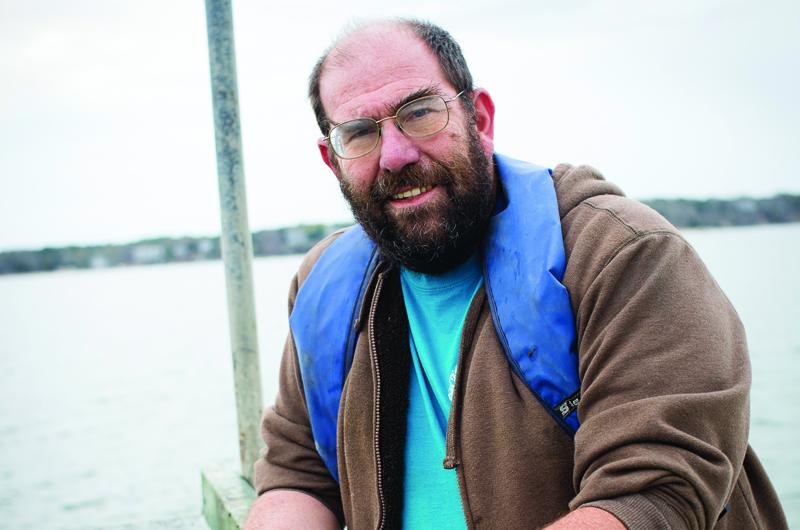
“Because of the amount of phytoplankton in the water at times, and the depth itself, no light gets to the bottom,” he said of the deepest area, farthest from the inlet. “So no seaweeds or eelgrass or anything like that can live in there.” With the loss of eelgrass, a key indicator species, comes the loss of shellfish and other animals that depend on it for food and habitat. The scientific term for the process is eutrophication, and it’s a similar story for most of the Island’s fifteen major estuaries and about a dozen smaller ponds, most of which are experiencing varying levels of impairment.
Lagoon Pond, at the northern tip of the Island, is shaped roughly like a carrot. It is split right down the middle, with the eastern half in Oak Bluffs and the western half in Tisbury. The estuary itself, including the “west arm” tributary cove and a small freshwater pond at the southern tip known as Upper Lagoon Pond, covers about 570 acres. But its watershed spans more than 4,000 acres in Oak Bluffs, Tisbury, West Tisbury, and Edgartown. The pond’s visibility and accessibility have made it something of a flagship among the nitrogen-impaired estuaries of the Vineyard.
Despite its problems, the Lagoon is still considered one of the primary scallop fisheries on the Island, although historical data for individual ponds are somewhat lacking. Between 2000 and 2007, the annual scallop yields in Tisbury and Oak Bluffs averaged about 2,793 bushels and 1,186 bushels, respectively. But that includes other estuaries besides the Lagoon. More important, recent harvests are a pittance compared with those of a half century ago. A report by biologist Sandra MacFarlane in 1999 found that Vineyard scallop harvests as a whole declined from 15,000 bushels in 1982 to 2,000 bushels in 1997. (Biologists still don’t fully understand what caused a widespread decline in scallop fisheries in the 1980s.) Grunden estimated that the Lagoon’s annual scallop harvests have fallen by at least half since the 1970s.
“By ’76 there was already a marked decline in shellfish landing,” he said, noting the shellfish group’s early mission to preserve the Island fisheries. There was hope at that time that maybe the problem was cyclical, and that with a little boost from a hatchery the shellfish harvests would improve. But by the 1980s it was becoming clear that more needed to be done. In 1987 Bruce Poole, a marine scientist, issued a report to Oak Bluffs and Tisbury lending credence to the public perception that the Lagoon was in decline.
“You’ve seen it on your moorings, on your anchorings, and on your beaches,” Poole said at the time. “There are not enough crabs, shrimp, or worms to consume all the algae being produced in the pond.” In a worst-case scenario, he gave the pond five years before all of its shellfish would be gone.
And yet, the booming 1990s came and went, along with the first decade of the new millennium, and little was done other than to continue studying the problem. Poole’s five-year prediction may have been an overstatement, but there’s no denying the Lagoon continued its relentless decline. These days, according to Grunden, the shellfish constable, “a lot of the fishermen now realize that the pond seems to be dying.”
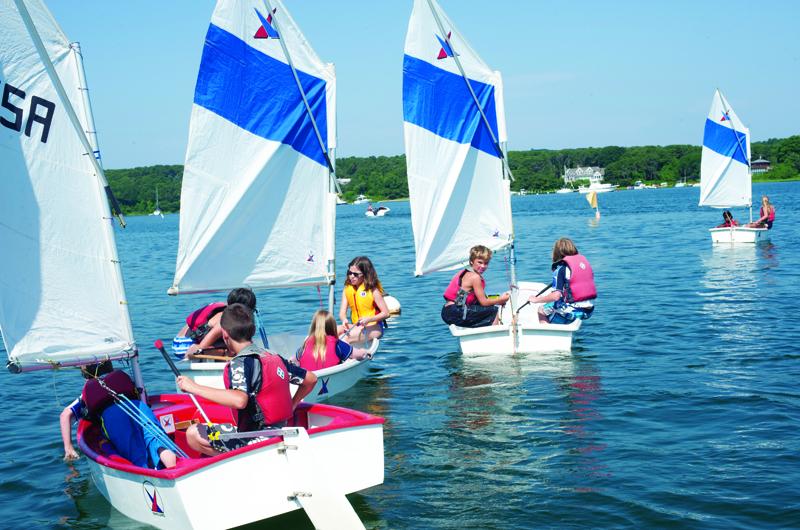
There is no mystery as to what is causing the decline. Estuaries everywhere are suffering from the effects of land-use changes and housing booms that have drastically increased the amount of nutrients entering the ground and making their way eventually to the water. The major culprit is nitrogen, most of which came from human waste. According to a study completed five years ago by the Massachusetts Estuaries Project (MEP) – a long-term partnership between the Department of Environmental Protection and the University of Massachusetts – fully three-quarters of the controllable nitrogen in the Lagoon comes from septic systems. The rest is from fertilizers, agriculture, and road runoff.
Every time a toilet flushes, some amount of nitrogen from the food we eat enters the ground, and eventually finds its way into a body of water. While sewer systems can remove most of the nitrogen from wastewater, rural areas such as the Vineyard rely largely on septic systems. The state-regulated Title 5 systems, along with most sewers, were designed to remove bacteria, not nitrogen, so many watersheds are defenseless against
eutrophication.
Even more alarming, because groundwater travels only about a foot per day, even if a state-of-the-art sewer system could be installed overnight it likely would likely not affect the current state of the pond. At the head of the Lagoon watershed, near the south end of Lambert’s Cove Road in West Tisbury, there is no water in sight, only a dirt road and a few homes tucked away in the woods. The nitrogen from toilets that were flushed here in 1975 may only now be reaching the open water.
“We’re noticing all this degradation of our ponds now,” said Melinda Loberg, a Tisbury selectman and chair of the wastewater commission. “And yet there is a lot of development that has taken place in the last fifteen years that we haven’t even seen the impact of yet. So it’s pretty scary.”
Loberg has served on the town finance committee, the town harbor management committee, and several other Island boards. She is also the former president of Tisbury Waterways Inc., which formed in 1988 in response to concerns surrounding pollution in Vineyard Haven harbor. When she first ran for selectman last year, it was largely with environmental issues in mind. “I figure I owe it to myself, my grandchildren, everybody’s grandchildren,” she said of the efforts to restore the Lagoon. “It’s a resource that we’re just borrowing. And when we’re here we should be taking
care of it.”
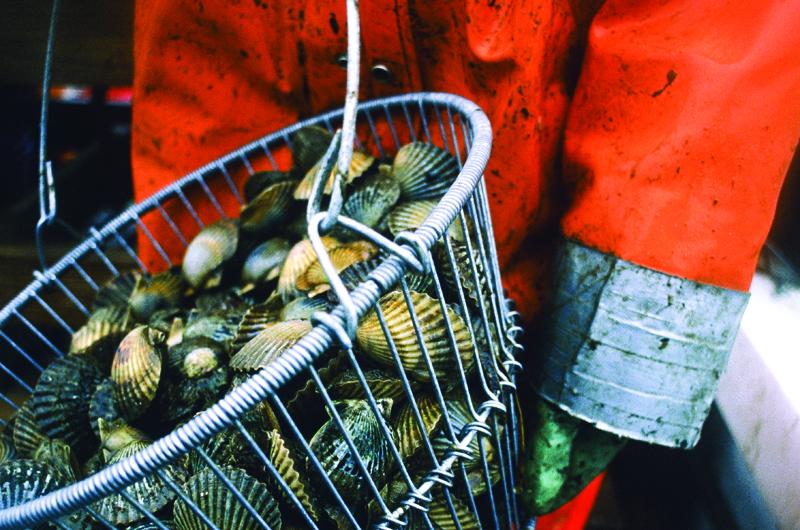
The crux of the Massachusetts Estuary Project report on the Lagoon in 2012 was that the towns should be aiming to reduce the amount of human-caused nitrogen entering the pond by roughly 50 percent, to about 74 kilograms (163 pounds) of nitrogen per day. It’s an ambitious goal, one that town officials and Island planners say will require millions of dollars and a variety of approaches over many years. But after decades of inaction, while the pond continued to deteriorate, just having a concrete and reliable goal is progress. And there is some indication that at last a critical mass of citizens in both Oak Bluffs and Tisbury is determined to take constructive action to reverse the decline.
While no one is officially responsible for the health of the Lagoon, Tisbury Waterways and the Lagoon Pond Association, in Oak Bluffs, have made it their mission to work together to raise awareness and help achieve the MEP limit. Each group includes selectmen, town planners, and other officials, many of them longtime Islanders who have watched as houses have proliferated and the natural habitat has declined. In recent years public awareness has gained momentum, partly as the result of public outreach.
The progress may seem slow, but in some ways the Vineyard is ahead of the curve. Grunden pointed out that Oak Bluffs is ready to spend about $1.5 million to install two eight-foot culverts at Farm Pond, a smaller estuary to the east of the Lagoon, which is also impaired, although less severely. (Most of the money is coming from a federal grant.) Town officials and the MEP expect the culvert solution alone will achieve the pond’s nitrogen limit. “I think it will be the first pond on the Island and one of the first coastal ponds in the state that would meet the Clean Water Act of 1972,” Grunden said.
The MEP provides numbers and analysis, but the towns are left to come up with specific solutions. In Oak Bluffs and Tisbury, and elsewhere on the Island, that will require a good deal of cooperation. To carry the process forward, Oak Bluffs and Tisbury have formed a joint watershed committee, likely the first of its kind on the Island, to explore shared solutions for the Lagoon. The committee has already assembled a spreadsheet of all the regulations that apply to wastewater in each town, Loberg said. “We are trying to see where the gaps are, whether we have similar regulations or whether they can be made to be more similar in the watersheds that we share,” she said.
She was quick to point out that nitrogen is not adequately covered by current regulations in either town, but she believes significant changes in both towns are inevitable. “We pretty much understand the needs,” she said. “When you have a body of water that lies in two different towns or more, it’s important that we respond together.”
The shape of the change to come is unclear, but the solutions will likely include expanded sewering, alternative septic systems, and experimental aquaculture techniques. Each solution will be tried, evaluated, and tried again over a number of years.
One idea that has floated around for years is a nitrogen tax, also called a “flush tax” or “pee fee,” to help fund nitrogen mitigation efforts around the Island. The state of Maryland already has one to help pay for upgraded sewer systems and septic tanks, and other efforts in the Chesapeake Bay watershed.
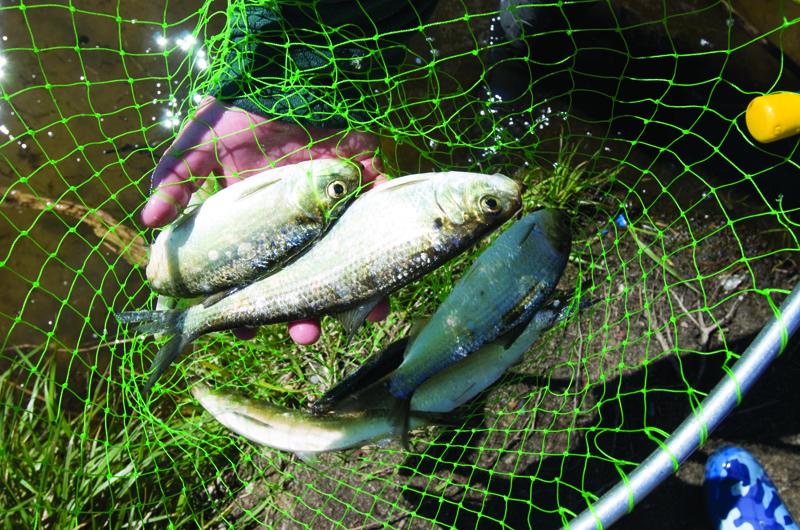
The Martha’s Vineyard Commission – which was initially slow to create a district of critical planning concern (DCPC) around the pond, but did so in 1988 – has limited power. The DCPC extends 1,500 feet from the shore and the MVC can only require nitrogen removal systems for new developments of regional impact, not existing single-family homes. Nor is the MVC anxious to do all the heavy political lifting required to save the ponds.
“We just do pieces here and there,” said MVC water resources planner Sheri Caseau. “We would love to work with the towns and get a nitrogen limit for all the towns to have, so that it wouldn’t just be the commission that’s limiting.” But that would be a long-term goal. “Within ten years,” she said, “we’d like to see progress on it.”
Shellfish committees in Oak Bluffs and Tisbury are generally onboard with the efforts, said Grunden, who is a member of both the Lagoon Pond Association and the joint watershed committee. “I don’t know if they are all in favor of spending millions and increasing their tax rates,” he said. “But they recognize that we have to do something to save the ponds. Not just Lagoon, but all the ponds.”
The idea is to start small. Following the MEP report in 2012, for example, Oak Bluffs commissioned a study of the Upper Lagoon Pond, which is separated from the main basin by a strip of land through which a culvert allows water to flow between the two bodies of water. As one simple solution, the town plans to shorten the pipe and place a duckbill valve at one end so water can only flow out to the main basin. That will reduce the salt content in the smaller pond and, since fresh water intercepts more nitrogen than salt water, should lower the overall nitrogen load in the system. Other first-line solutions include the Island-wide fertilizer regulations that went into effect this year, and catch basins at the foot of hills to control runoff.
But even all of those solutions combined will fall well short of the goal, said Caseau, who is working with both towns to collect data and analyze the solutions. “We are taking little bites out of it, but we are going to end up having to sewer,” she said.
“For Lagoon, it’s going to require sewering in both towns,” said Grunden. “If one town did all the sewering and the other town didn’t, I don’t think we’d meet the upper limits for the Clean Water Act. Both towns will have to act. Both towns will have to sewer. Both towns will have to spend millions of dollars.”
Another study by the MEP in 2011 found that adding sewers to an area south of Barnes Road and north of the Upper Lagoon Pond in Oak Bluffs could eliminate up to 18 percent of the pond’s overall nitrogen load each year. That came as a surprise to some town officials, who originally had their eye on an area just north of Barnes Road that is more heavily developed. But that area is also closer to the inlet, so the nitrogen it produces is flushed away faster. In Tisbury, the neighborhood around Oklahoma Avenue is also a candidate for sewering. Expensive as it is, sewering is perhaps the most reliable long-term solution because it removes the nitrogen before it has a chance to get to the pond.
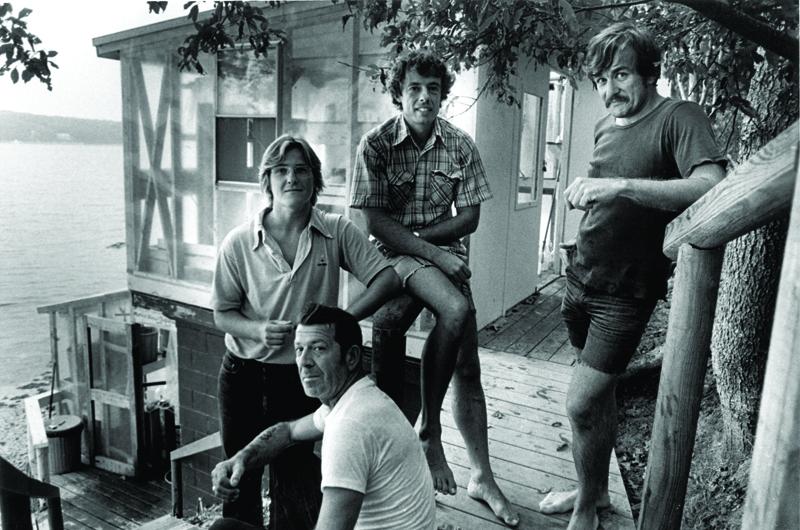
But sewage systems are years off, at best, and don’t do anything about the nitrogen already in the soil working its way relentlessly toward the open water of the Lagoon. With that in mind the Martha’s Vineyard Shellfish Group has been studying techniques for actually removing nitrogen from the water. Oysters are strong filter feeders, for example, and it’s possible that adding enough of them to the pond could lower the nitrogen levels to the MEP limit. But that would require about 15 million of them annually, which shellfish group director Rick Karney believes would be impractical. Instead, the shellfish group and Tisbury shellfish constable Danielle Ewart have been experimenting with oyster reefs in the west arm of the Lagoon, where the salinity is lower, making for a better oyster habitat. Large piles of shells at the bottom of the pond provide an anchor, or reef, for the growing oysters and help to balance the water’s acidity. The project is still in its infancy, but may eventually offer some relief to the west arm.
Ironically, perhaps, a plant more often considered an environmental villain might be enlisted in the fight to save the pond. Last year, with a grant from the Edey Foundation, the shellfish group worked with researchers at the Marine Biological Laboratory in Woods Hole to analyze how well the invasive wetland grass phragmites absorbs nitrogen.
“What’s really exciting is that an acre of harvested phragmites would be equal in nitrogen content to half a million three-year-old oysters,” said Karney. “To produce half a million market-size oysters is not an easy feat.” The shellfish group is currently looking for funding for the next phase of research, which will involve looking at the plant’s uptake ability and potential uses over multiple generations.
The main obstacle for the aquaculture solutions is bureaucratic: most have not been fully recognized by the state as a viable method for removing nitrogen. The Department of Environmental Protection, which oversees the MEP, will be the final judge of what techniques officially count toward nitrogen reduction. Though Karney believes the state is warming to the use of oysters, he said that even oyster reefs would be a tough sell.
The Island is not alone in the effort, however. A demonstration project in Little Pond in Falmouth was started in 2013 with the aim of better quantifying the relationship between oysters and water quality, and similar projects are underway in Mashpee and Wellfleet. As damaged as the Vineyard ponds are, many of the forty-five estuaries on the Cape are in much worse shape, largely as a result of the widespread development and resulting higher population density on the peninsula. In response, the Cape Cod Commission, a regulatory and planning agency similar to the MVC, has made enormous progress in analyzing the problem and charting a course forward. And the MEP has helped to inform its efforts. Island officials are now looking to the Cape as a critical partner as towns begin to shift from research and analysis to implementation.
As part of its regional plan for water quality management, the Cape Cod Commission identified nearly every conceivable strategy for removing nitrogen from its estuaries and collected them in a computer modeling program that can show how various solutions might unfold. This should help remove some of the uncertainty surrounding specific technologies and allow voters and officials to focus more on the larger goals. According to Loberg, so far the Cape Cod Commission has been generous in sharing its technology. “They have spent hundreds of thousands of dollars building these models,” she said, “and they will be very useful to us when it’s our turn to get there.”
Regardless of what solutions eventually come into play, there are going to be some enormous costs involved in reversing the decline of the Lagoon and the rest of the threatened ponds on Martha’s Vineyard. Tisbury Waterways and the Lagoon Pond Association are now looking for funding sources, and the Cape Cod Commission may offer some new tools for understanding costs and financing. Town officials are also hoping that a multi-town effort would show regional support and help obtain state funding.
Even in a best-case funding scenario, it’s hard to envision a situation in which the towns on the Island – all of them – will not have to step up to the plate and find the revenue necessary to save the Lagoon and other ponds. Though towns have been under no obligation to meet the nitrogen limits recommended by the MEP, most people familiar with the program expect the state will eventually make the recommended nitrogen reduction mandatory.
It’s worth remembering, however, that the price of not doing anything about the ponds for all these decades has also been steep. In the early 1970s, Tisbury and Oak Bluffs each harvested an average of roughly 10,000 more pounds of bay scallops every year than they did by the early 2000s. At today’s retail price of roughly $20 per pound, those missing scallops would be worth about $200,000 a year per town at the fish market. Extrapolate those losses to the Island-wide decline in shellfish and multiply it by forty-five years and waste treatment looks like a pretty good long-term investment.
“This is going to be a twenty-to-forty year process,” said Loberg, who remembers digging for quahaugs with her grandfather in Tisbury at a time when the shellfish were far more abundant and no one was very worried about wastewater. She expects the public decision-making process on the Vineyard to begin in earnest this year, and while looking that far ahead may be a tall order for a public with more immediate concerns, she believes people here are finally ready for the challenge.
“They get it,” she said. “And every time we talk about this in a public place, people say, ‘Let’s get on with it.’”




 3 comments
3 comments
Comments (3)